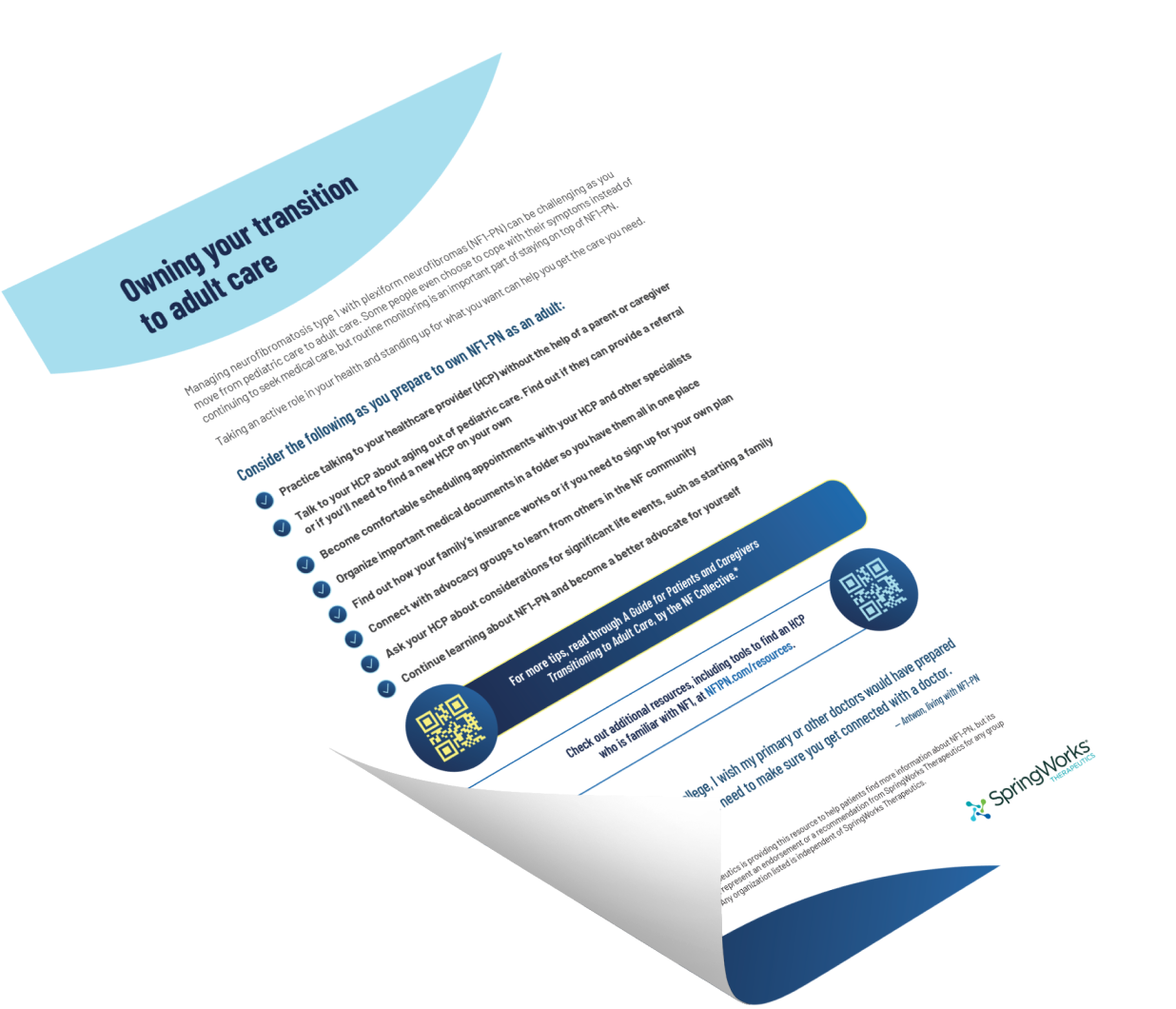This site is intended for US healthcare professionals

Life with NF1-PN changes as patients get older

Sometimes it felt like I was alone in caring for my condition.
– Vanessa, living with NF1-PN
NF1-PN can be especially challenging for adult patients
Turning 18: What I wish I knew
Antwan shares his experience transitioning to adult care.
Before I left for college, I remember seeing my pediatrician.
He just kind of, like, checked me out and just, you know, just told me to take care of myself, and he said, “If you need me before you turn 18, you can always come back.”
But as far as, like, connecting me with any, like, doctors, he honestly really didn’t do much.
That transition of care was really, I guess I just wasn’t educated enough to know what I actually needed to do.
I knew if you get sick, you go to the doctor, but I wasn’t really educated on, like, okay, because you have these health challenges growing up, you need to get connected with another doctor when you get, you know, settled.
I just thought, you know, no big deal. I’m going away to school. Like, you know, I’m fine for the most part. But when I got sick in 2010, that’s when I really got connected with, like, a primary doctor. And I started seeing the primary, and then I had to see a pulmonologist, and then I saw my oncologist.
And they started, kind of, took over everything, and, like, since 2010 I’ve been seeing doctors on the regular.
But I just wish they would have, like, had that conversation. You know, encouraged me to connect with a doctor versus waiting until I got sick to connect.
Like, hey, you, you need to be serious. Take your medical care seriously. Or, like, made a referral or something.
But no one ever, like, they never, like, prepared me for that, that transition.
Turning 18: What I wish I knew
Antwan shares his experience transitioning to adult care.
Before I left for college, I remember seeing my pediatrician.
He just kind of, like, checked me out and just, you know, just told me to take care of myself, and he said, “If you need me before you turn 18, you can always come back.”
But as far as, like, connecting me with any, like, doctors, he honestly really didn’t do much.
That transition of care was really, I guess I just wasn’t educated enough to know what I actually needed to do.
I knew if you get sick, you go to the doctor, but I wasn’t really educated on, like, okay, because you have these health challenges growing up, you need to get connected with another doctor when you get, you know, settled.
I just thought, you know, no big deal. I’m going away to school. Like, you know, I’m fine for the most part. But when I got sick in 2010, that’s when I really got connected with, like, a primary doctor. And I started seeing the primary, and then I had to see a pulmonologist, and then I saw my oncologist.
And they started, kind of, took over everything, and, like, since 2010 I’ve been seeing doctors on the regular.
But I just wish they would have, like, had that conversation. You know, encouraged me to connect with a doctor versus waiting until I got sick to connect.
Like, hey, you, you need to be serious. Take your medical care seriously. Or, like, made a referral or something.
But no one ever, like, they never, like, prepared me for that, that transition.
Adult patients have fewer options for where they can
receive specialized care.1,2
US clinics within the NF Clinic Network*
Adapted from the Children's Tumor Foundation website. For illustrative purposes only.
* “Pediatric/Adult” includes clinics that can see select adult patients up to a certain age and clinics that can see adult patients with no age limit.
Many patients disengage from care during the transition to adulthood
- Financial and travel barriers
- Difficulty coordinating appointments
- Lack of approved treatment options
- An unwillingness to monitor tumors that aren’t causing acute symptoms
Transition-to-adult-care checklist
How you can help
You have the expertise and skills to help patients manage their NF1-PN rather than just live with it.
Based on SpringWorks Therapeutics–sponsored market research that included 4 adult NF1-PN patients and 11 NF1-PN caregivers. Both patients and caregivers were asked to identify the emotional and experiential impact of NF1-PN on patients.7
- Radtke HB, Berger A, Skelton T, Goetsch Weisman A. Neurofibromatosis type 1 (NF1): addressing the transition from pediatric to adult care. Pediatric Health Med Ther. 2023;14:19-32.
- Gregory TA, Molina PSB, Phillips GD, Henson JW. Impact of neurofibromatosis type 1 in an adult community population. Neurooncol Pract. 2022;9(3):229-235.
- Lai J-S, Jensen SE, Patel ZS, Listernick R, Charrow J. Using a qualitative approach to conceptualize concerns of patients with neurofibromatosis type 1 associated plexiform neurofibromas (pNF) across the lifespan. Am J Med Genet A. 2017;173(1):79-87.
- Rietman AB, van Helden H, Both PH, et al. Worries and needs of adults and parents of adults with neurofibromatosis type 1. Am J Med Genet A. 2018;176(5):1150-1160.
- Siegel A, Lockridge R, Struemph KL, et al. Perceived transition readiness among adolescents and young adults with neurofibromatosis type 1 and plexiform neurofibromas: a cross-sectional descriptive study. J Pediatr Psychol. 2024:jsae006.
- Goetsch Weisman A, Haws T, Lee J, Lewis AM, Srdanovic N, Radtke HB. Transition readiness assessment in adolescents and young adults with neurofibromatosis type 1 (NF1). Compr Child Adolesc Nurs. 2023;46(3):223-239.
- Data on file: SpringWorks Therapeutics, Inc.
- Foji S, Mohammadi E, Sanagoo A, Jouybari L. How do people with neurofibromatosis type 1 (the forgotten victims) live? a grounded theory study. Health Expect. 2022;25(2):659-666.
